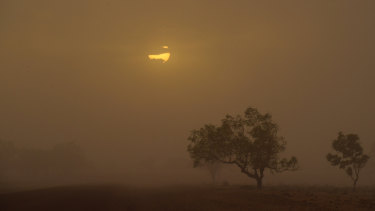Nationally, rainfall was more than 60 per cent below average. Tasmania's totals were just one-fifth of the norm, making it the state's driest January on record.
'Dome of hot air': Australia blows away heat records

Hot and dry: a dust storm near Bourke on the evening of January 17. The region recorded Australia's highest minimum temperature, 36.6 degrees.CREDIT:KATE GERAGHTY
2 February, 2019
Australia in January smashed its heat records for any month with "extraordinary" overnight and daytime temperatures both beating previous national highs by about 1 degree. NSW shattered its records by twice that.
Minimum average temperatures across Australia were 2.91 degrees above the 1961-90 benchmark, 0.99 degrees higher than the previous record set in January 2013.
Hot and dry: a dust storm near Bourke on the evening of January 17. The region recorded Australia's highest minimum temperature, 36.6 degrees.
Maximum temperatures were almost as remarkable, coming in at 0.89 degrees above the previous high mark set in the same month. That was 3.37 degrees above the 1961-90 average, the bureau said in a report

In NSW, the departure from previous records was more than 2 degrees, with daytime temperatures more than 6 degrees above normal, with overnight ones beating previous high marks by almost as much.
That result was "nothing like I've seen before", Sophie Lewis, a climate researcher at the University of NSW, specialising in heatwaves, told the Herald. "It's huge."
All states and territories bar Queensland set a record for January daytime temperatures, with that state coming in at fifth-warmest.
All but South Australia and Western Australia notched their warmest January for overnight temperatures, with those two states marking their second-warmest.
"We had long strings of very high temperatures," Andrew Watkins, head of climate prediction services, said
Bourke in north-west NSW was one place seared by "an exceptionally long and intense heatwave", with 21 days in a row above 40 degrees from January 9-29, he said.
 The nearby town of Borrona Downs also registered the highest recorded overnight temperature of 36.6 degrees.
The nearby town of Borrona Downs also registered the highest recorded overnight temperature of 36.6 degrees.
Nationally, rainfall was more than 60 per cent below average. Tasmania's totals were just one-fifth of the norm, making it the state's driest January on record.
Victoria didn't fare much better, with just over one-quarter the January average, while NSW was down 60 per cent and the Murray-Darling Basin off 71 per cent.

'Dome of heat'
The bureau attributed the persistence of stable and sunny conditions over much of the country and a delayed onset of the monsoon over northern Australia for creating "ideal conditions" for the heat build-up.
"This dome of hot air over the continent has brought extreme heat to various areas as weather systems - particularly troughs - have introduced extremely hot air into different regions," the bureau said.
There was "little penetration of cooler air from the south to disrupt the hot, continental air mass", it added.
Among the dozens of heat records to be broken last month included the three hottest days nationwide, by mean temperatures. These were the 32.63 degrees set on January 22, followed by 32.48 and 32.45 degrees on January 16 and 2, respectively.
By the end of last month, Australia had notched up eight of the top 10 hottest days for mean and minimum temperatures ever recorded in the country - in the one month.
In peer-reviewed research, Dr Lewis had attributed the extremes of the previous record hot month - January 2013 - as 15 times more likely to have occurred because of climate change.
Last month, that multiplier was "around 50-fold", she said, adding the high readings were "a really strong signal from climate change".
City heat and outlook
Sydney was among the major cities to bake in record heat.
The city equalled its hottest year for daytime temperatures, set in 2017, with an average maximum of 29.6 degrees - or 3.6 degrees above the norm for Observatory Hill.
Bankstown, Parramatta North and Camden were among sites to set record daytime readings last month.
Minimum temperatures also set records, including for Observatory Hill with its 160 years of data. Sydney's overnight temperatures were 2.9 degrees above the norm, at 21.7 degrees, also eclipsing the old record set in January 2017.
Relative humidity also averaged 70 per cent at 9am, making for a muggy month for many in Sydney.
Melbourne also had one of its warmest Januaries, with maximums average across the city the highest since at least 1990, the bureau said.
With record January heat following a record hot December, chances are good that Australia as a whole will give the summer records a shake.
"The odds are favouring that the heat will continue through February and into March and April," Dr Watkins said, referring to the bureau's three-month outlook updated this week.
For rainfall, the odds strongly favour a drier-than-normal February-April period for Western Australia, while eastern states mostly face more average conditions, the bureau said.
"We get these super-summer temperatures now, and summer-like temperatures in autumn," Dr Lewis said




No comments:
Post a Comment
Note: only a member of this blog may post a comment.